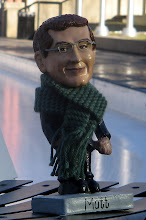After reading through the first movement, Pierre quickly realized that he was working with a pre-installed interpretation, and a bit of rehearsal time was spent cleaning up some of the squiggles and dashes. Most of them make sense musically -- a lot of them would probably be done automatically, without being marked. But having them in the part leads to a bit of an exaggerated effect, as though I were to write my BLOG with all the IMPORTANT words marked for EMPHASIS!!
/ -- Ivars calls this one a stress
u -- a 'de-stress', a saucer shape often confused for an up-bow
^^^^ -- a squiggly line meaning 'do something interesting'; I like to call it a schmearando
Pierre remarked that he was going for more of a 'bread and butter' Beethoven, which quickly got turned back at him with all sorts of variations -- after he suggested some ornamentation in the opening Adagio, a bassoonist said, "I thought you wanted meat and potatoes," then others suggested rice and beans, beer and pretzels, black and tan, etc. I would have preferred lox and schmear, though that might be the Ivars markings talking.


 Technorati Link Count: no. of blog reactions to this post
Technorati Link Count: no. of blog reactions to this post
3 comments:
I love the schmearando. For me, it has replaced forward and backward arrows and eyeglasses. Seeing the squiggle reminds me to look up, then do something interesting, reflecting what I see on the podium. A very efficient marking.
I've gotten used to the smearando myself - But "something special" means different things to different people.
When I follow my inner specialness with this marking I find myself playing longer note lengths and slightly behind my stand partner!
Mind you - I think precision is beside the point with this marking.
My concern with the Ivars system is that it could induce a sort of paint-by-numbers approach to musicianship. There's so much on the page, we can forget to interact and be attentive to what's not.
In fairness to Ivars though, he's an extremely musical conductor who always has a bigger vision, even as he's micromanaging the small stuff.
Post a Comment